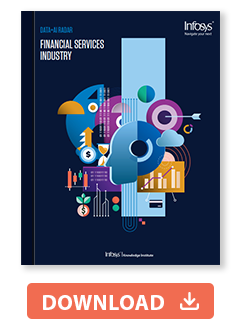Insights
- The Data+AI Radar 2022 surveyed 2,500 AI practitioners from companies across 12 industries with annual revenues exceeding $500 million in the US, UK, Germany, France, Australia, and New Zealand.
- The study found that financial services firms still struggle with legacy estate and biases infiltrating AI systems.
- They are better than the average of all industries at data collection, data verification, and deep learning, all of which relate to long-term positive business and AI outcomes.
- The financial services industry reports the highest satisfaction rates with their AI deployments.
- To truly lead, the financial services industry must improve its ability to identify problems AI can address, invest in AI infrastructure and computing resources, and phase out legacy systems.
Investments into AI on the rise
“Artificial intelligence (AI) is an extraordinary and groundbreaking technology. AI and the raw material that feeds it, data, will be critical to our company’s future success.” When Jamie Dimon, the CEO of JPMorgan Chase, talks, the industry listens — and he could not have emphasized enough on the importance of AI. Data and AI’s influence is ingrained in the firm’s technology strategy. Yet, our research shows that financial services firms were slow to embrace AI.
Global AI spending on systems, services, and platforms will more than double to $300 billion by 2026, according to IDC, and the financial services sector is expected to hold most of that share.
Dennis Gada, EVP and global head of Banking and Financial Services at Infosys, stated that financial services spend on AI continues to grow rapidly and AI adoption will transcend all businesses and functions either to improve experience, strengthen resiliency, or boost innovation. They will do so in an environment where they must compete with big tech companies to capture the best AI talent.
Recent developments in generative AI, such as ChatGPT, inspire consumers and companies with new opportunities. Jane Fraser, Citi’s CEO, mentioned that the firm has been working on generative models that power ChatGPT for the past three years. She added that generative AI will drastically improve productivity and has the potential to change how code is written, onboard clients, service customers, detect fraud, develop market research, and strengthen compliance and controls.
But financial services firms still lag. While one-fifth of other industries began deploying AI over five years back, only 8% of financial services firms began during the same time frame, according to Infosys Knowledge Institute’s recent research. Financial services firms began using AI for more basic needs, rather than advanced use cases, as seen in other industries. Perhaps due to the highly regulated nature of the industry and skepticism about the technology’s outcomes.
But that thinking has changed. “Financial services firms are now stepping ahead and forward in their AI investments vs. other industries,” said Bal Shukla, AVP, group manager at Infosys. “While that wasn’t the case five years ago, in 2023, they will be the largest investors in the AI market.”
The Data+AI Radar 2022 surveyed 2,500 AI practitioners from companies across 12 industries with annual revenues exceeding $500 million in the US, UK, Germany, France, Australia, and New Zealand. The study found that financial services firms still struggle with legacy estate and biases infiltrating AI systems. They also continue to face basic issues such as a lack of subject matter knowledge.
However, there is a glimmer of hope for the industry. Financial services firms are better than average at data collection, data verification, and deep learning, all of which relate to long-term positive business and AI outcomes. Interestingly, they report the highest satisfaction rates with their AI deployments. To truly lead, the industry must improve its ability to identify problems AI can address, invest in AI infrastructure and computing resources, and phase out legacy systems.
Financial services lag other industries in AI deployment
AI is not new. But it is now more prevalent in businesses than ever before. A decade ago, digital giants, including Amazon, Google, and Microsoft, dominated most data and AI activities. Around the turn of the millennium, these companies had two key advantages that most enterprises lacked: zettabytes of data and petahertz of computing power. Now, every company resembles Amazon in 2001: gallons of data flow into corporate reservoirs, and computing power can be easily scaled up at the touch of a button. The result: AI is spreading like wildfire. However, most firms are new to attempting their own advanced AI.
Our study found that two of 10 companies deployed their first AI system five years ago, while only one of 10 financial services firms did the same (Figure 1). A majority of firms have implemented AI in the last two years. They are likely to require much more AI experience than this to successfully achieve higher-order capabilities.
Figure 1: AI deployment time frame
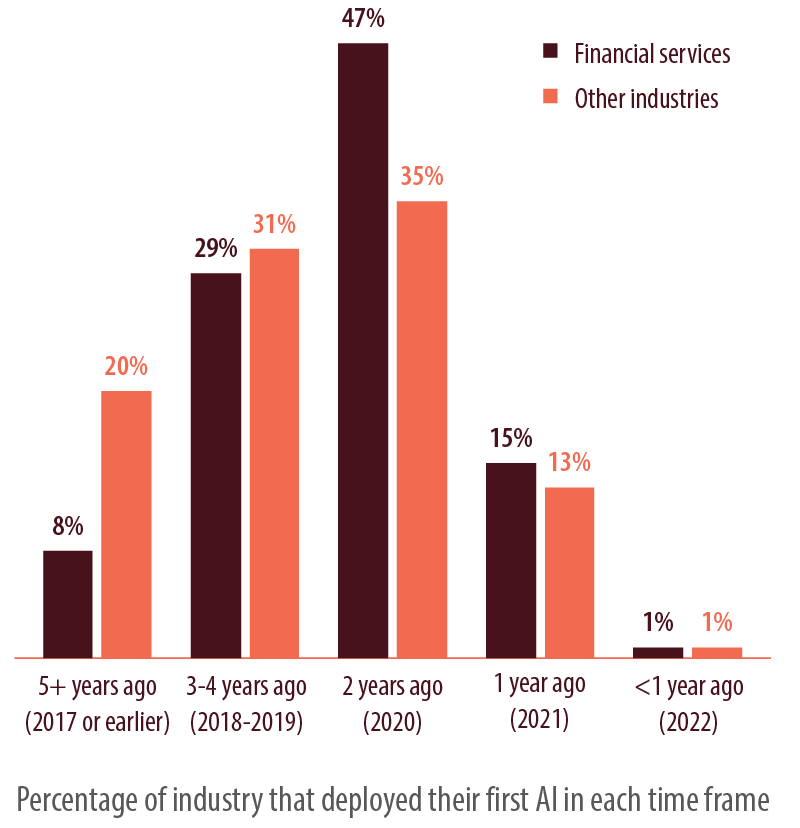
Source: Infosys Knowledge Institute
AI use cases are less mature than other industries
We asked respondents what capabilities AI systems deliver and scored answers across our Sense, Understand, Respond, Evolve (SURE) taxonomy (Figure 2). We found that financial services firms are laggards when it comes to achieving greater AI capabilities.
Figure 2: SURE taxonomy: Only 15% achieve top AI capabilities
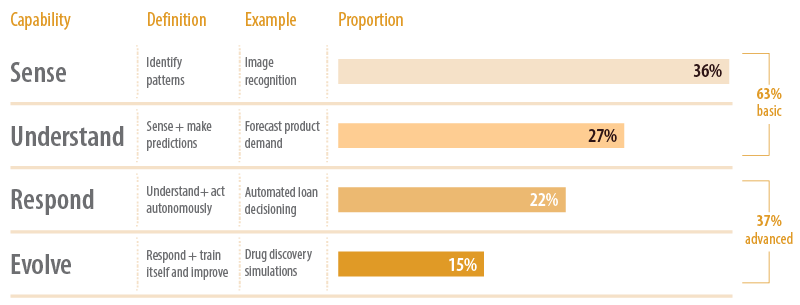
Source: Infosys Knowledge Institute
In capability terms, our analysis found that the middle tiers (Understand and Respond) link to profit increases, while the most basic tier (Sense) and most advanced tier (Evolve) lack business value at this point. However, compared to other industries, financial services firms have fewer use cases (64%) in the Understand and Respond stages (Figure 3), where their AI can only identify patterns, and sense and make predictions, which requires human involvement. Financial services firms only started AI deployment two years ago, and they are much more weighted toward the simpler AI use cases and are, therefore, lower on maturity. The most common use cases are around fraud detection and investment advisory. MorningStar’s Mo, an investment research assistant powered by generative AI, has answered over 25,000 questions, and the average cost per question answered is only $0.002 — two-tenths of a cent. Mo is designed to summarize Morningstar’s independent insights for investors and investment professionals.
Figure 3: SURE taxonomy: Only 15% financial services firms achieve top AI capabilities
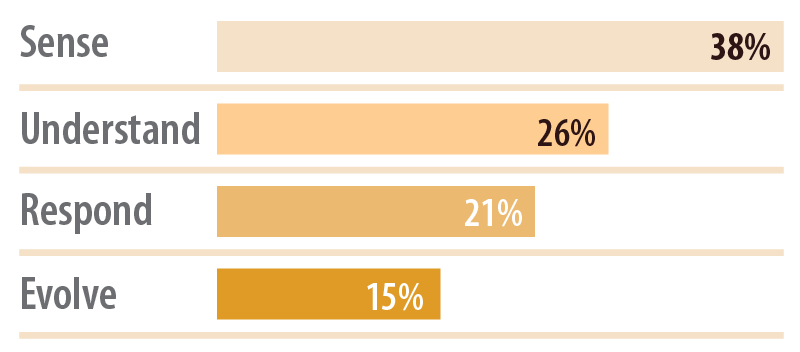
Source: Infosys Knowledge Institute
This direction is slowly changing. JPMorgan, for instance, has over 300 AI use cases spanning risk, prospecting, marketing, customer experience, and fraud prevention. AI has mitigated risk by reducing fraud and illicit activities, enhancing trading optimization and portfolio construction through optimal execution strategies, automated forecasting, analytics, and improved client intelligence. JPMorgan anticipates $1.5 billion in AI-driven business value by the end of 2023. Another example is Borealis AI, a research lab set up by the Royal Bank of Canada (RBC) in 2016. RBC Capital Market traders have built Aiden, an AI platform that improves trading results and insights for clients in a measurable and explainable way.
Legacy tech remains a major challenge to scaling AI
When asked about the top challenges, financial services highlighted their legacy landscape as a significant challenge, with nearly one-fifth of financial firms that have had AI systems in production for over five years facing this issue, vs. just 7% in other industries. One in six financial services firms cited insufficient subject matter knowledge as a challenge (Figure 4). These challenges relate to the fact that financial services firms lag other industries in AI deployment.
Figure 4: Top challenges faced by financial services respondents
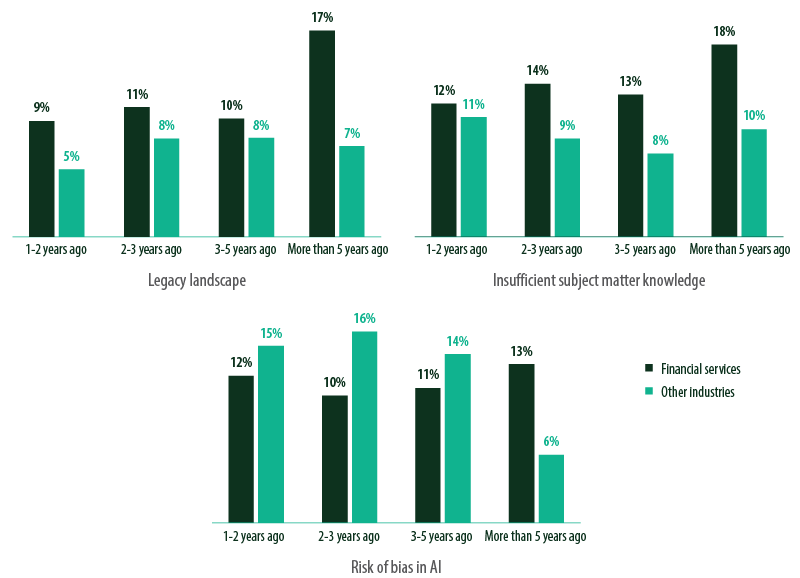
Source: Infosys Knowledge Institute
AI practitioners in industries with over five years of AI implementation see bias risk as less of a concern, while in financial services, it’s the opposite. Financial services firms that deployed AI within the last two to five years view bias as a lesser challenge compared to their counterparts in other industries. That could be attributed to their good data practices around data collection and data verification (Figure 5), potentially contributing to their higher satisfaction rates. However, a concerning pattern emerges: unlike other industries, financial services firms aren’t improving their bias management over time, possibly because it continues to be a critical issue for them. This ongoing concern likely stems from the heavy regulation that financial services face compared to other sectors.
Figure 5: Challenges faced by financial services respondents that wane over time
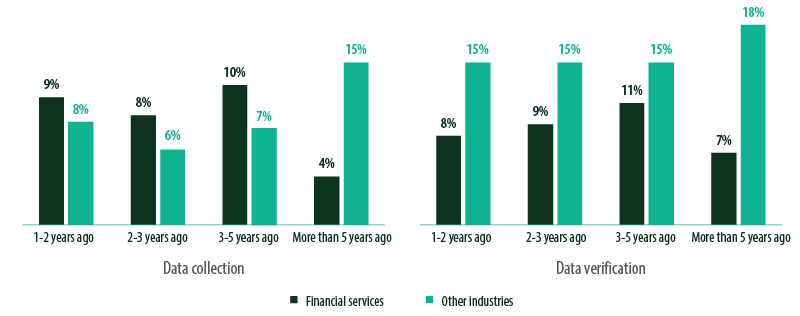
Source: Infosys Knowledge Institute
Financial services firms consistently report significantly higher percentages of the above challenges compared to other industries. A majority of financial firms have engaged in AI for just two years. What’s worrisome is that even those with over five years of AI experience still perceive these challenges as growing.
This trend suggests that these challenges are not diminishing over time; instead, they are increasingly acknowledged as significant issues.
The challenge of data verification persists across all levels of experience. However, it is not all glum for financial services firms. These firms are much stronger at data verification and data collection than other industries (Figure 5). While other surveyed industries that have had an AI system in production over five years ago stated data verification as one of their top challenges, financial services firms in this category face this issue to a much lesser extent. Their data and infrastructure management is notably structured, positioning them strongly for long-term success and satisfaction.
Regarding challenges like scaling AI and analytics and the shortage of skilled AI practitioners, financial services firms find these issues less challenging as they gain more experience.
The Infosys Knowledge Institute study also mapped use cases by satisfaction, usage levels, and frequency. We found that only 18 of 63 use cases (29%) achieved higher satisfaction scores. Notably, the financial services sector, with five specific use cases, reported the highest satisfaction levels across all industries, with all five use cases falling into the high satisfaction category. These use cases primarily revolve around fundamental functions like automated compliance and customer service tools within the financial services industry.
Figure 6: Industries ranked as per satisfaction rates
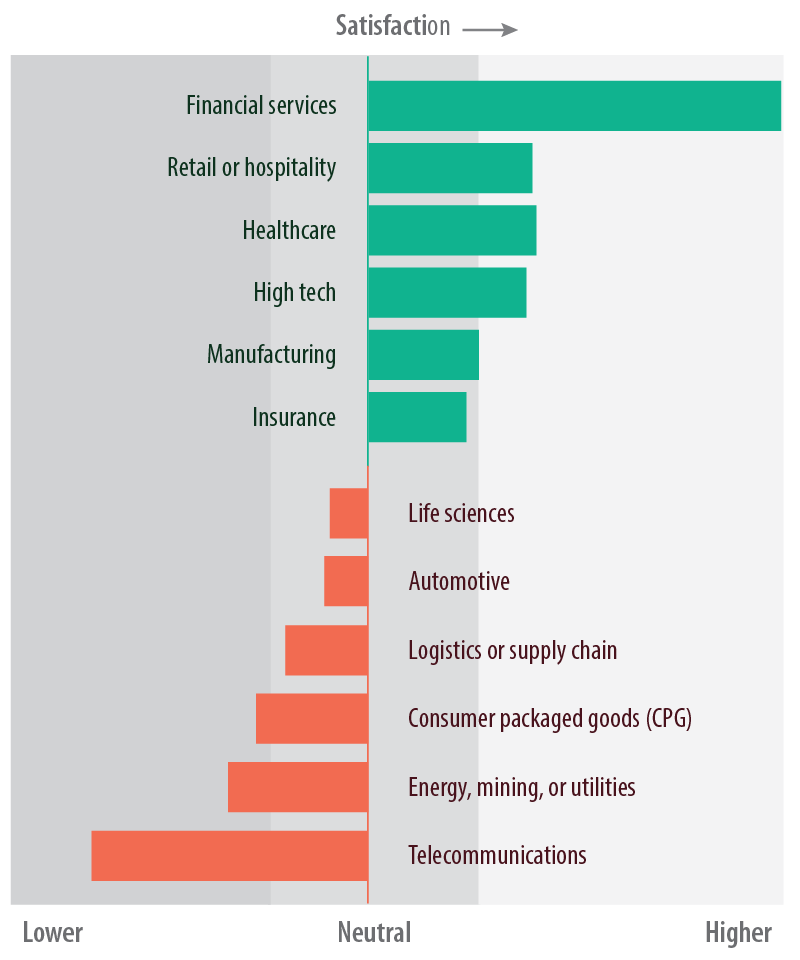
Source: Infosys Knowledge Institute
In the realm of data management, a significant shift is occurring. Most companies across industries plan to centralize their data architecture within the next two years. But those that are centralized are moving to a federated system. For financial services, there is movement from a mixed or federated to a centralized system, much like the market trend, except in a much larger proportion (Figure 7). For example, JPMorgan deploys a central but federated data strategy that emphasizes the importance of interoperability between data platforms.
Figure 7: How financial services firms manage data now and in the future
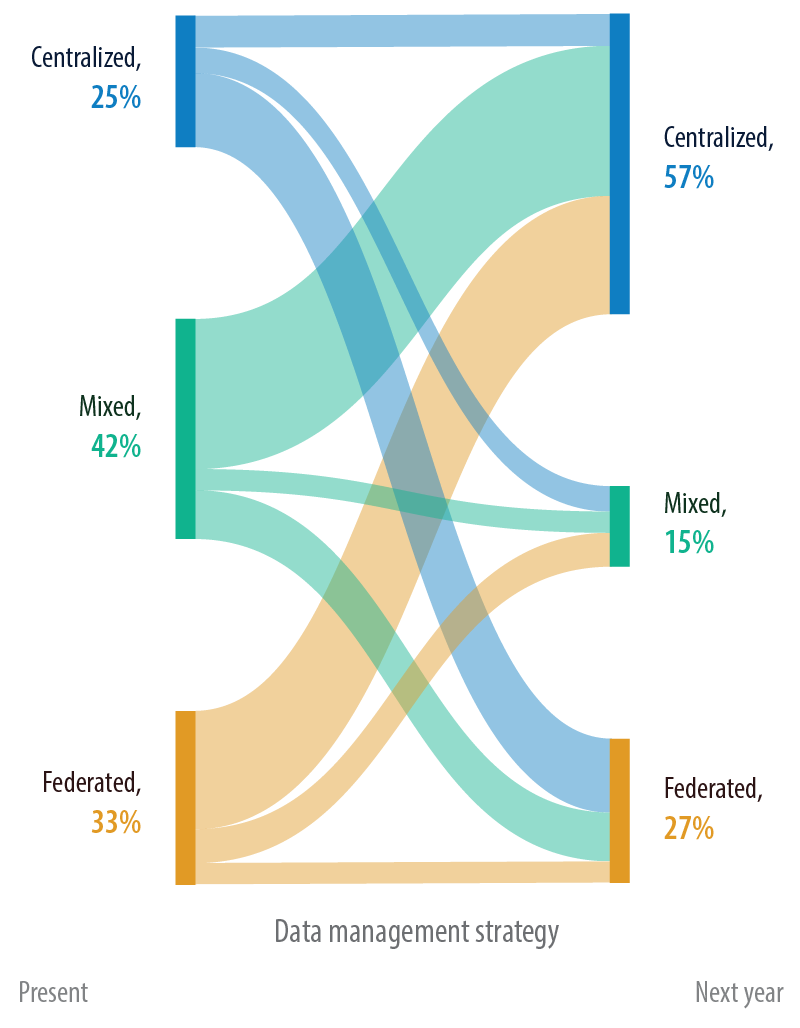
Source: Infosys Knowledge Institute
How financial services firms can succeed
The Infosys study shows that data and AI done well can lead companies to better financial outcomes and drive growth. Organizations can maximize the value of their data by adhering to certain best practices.
1) A cultural change and talent transformation to retire legacy systems
Jacqueline De Rojas, president-emeritus of techUK, a national trade group, said that low-quality data emitted from legacy systems is the most hidden and important challenge for driving AI adoption. “The power of algorithms has to be driven on clean data,” she states.
Infosys Modernization Radar 2022 shows that roughly 65% of discretionary budget is spent on modernization projects. “Financial services institutions are leveraging cloud for digital transformation, creating new customer journeys, and driving business agility. They are accelerating cloud adoption with a factory model and increasingly moving to hybrid multicloud states in a secure way. Some of them are also focusing on cloud-neutral and multicloud portability. The focus is also shifting to modernizing applications, building new cloud-native platforms and unlocking the power of their data on cloud with analytics and AI/ML use cases,” said Gada. Almost all legacy systems will either advance or disappear in the next five years. However, many executives fear failing. They want to change but are stuck in analysis paralysis.
Traditional financial institutions prioritize safety, stability, and caution, which contrasts with the consumer-centric, risk-taking, fast-testing, quick-failing, and agile nature of digital natives.
Cloud vendors, such as Google and Microsoft, have outstanding security expertise, and all are certified as compliant with global data governance standards. Despite this, technology teams face cultural barriers within their organizations. For instance, Stephanie von Friedeburg, then CIO of the World Bank, faced pushback from her legal team when she tried to modernize the organization’s technology. Eventually, she persevered and successfully convinced the international institution to embrace modernization.
One approach is microchange management. Instead of doing all changes at once, firms change employee behavior through slight modifications to habits and routines. This becomes particularly important when organizational culture has to catch up with the modernized technological landscape.
Retiring legacy assets is not a one-size-fits-all initiative. Different firms need diverse skillsets to realize true business benefits. That said, firms need to upskill, and take advantage of partnership opportunities for successful modernization. Many core applications are supported by aging teams of developers with hard-to-find skills.
At Citizens Bank, upskilling in APIs and modern microservices-based cloud-native architecture is part of what CIO Michael Ruttledge calls the multiyear next-generation technology (NGT) strategy. Ruttledge is aggressively investing in in-house talent, and upskilling and reskilling using hands-on engineering academies, technology immersion sessions, badging and certification programs, and like Infosys, online web-based learning solutions.
Financial services firms must enhance their legacy landscape for AI success. Our research shows that the lesser experience financial services firms have with AI, the lesser of a challenge legacy is. This suggests a decreasing reliance on legacy systems. Yet, to scale AI and analytics effectively, infrastructure modernization is crucial.
2) Shift attention from higher-order capabilities
Financial services firms must better identify AI’s problem-solving potential. Perfecting simpler deployments first and then tackling complex deployments can guide investment in the right AI infrastructure and resources.
3) A combined data management approach
Companies must have a defined data strategy for effective data management and seamless data ingestion, yet most lack this essential component. The Infosys study shows that centralized data management links to better profit and revenue growth. However, a shift to fully federated data management also increases profit growth. That said, both extremes are too simple to adequately serve as a comprehensive corporate data strategy.
Companies must strike a balance between centralization and federation and arrive at a state that fits their situation the best. For example, it could be a good practice to centralize data governance — rules around the structure, security, access, and storage of data — but federate ownership of data across the business, pertaining to aspects such as who updates it, gets value from it, and uses it. This holds good for financial services firms too.
4) Extensive data sharing drives deep learning
Like the unmined reservoir, data doesn’t have any intrinsic value, until you know what’s in it, said Sameli Mäenpää, chief data officer of OP Financial in Finland. “When you know what’s in it, you can derive assets out of it,” he added. “It only has value if you can connect it to something real.”
Having a data-sharing ecosystem with partners and peers yields greater benefits than a solitary data lake or warehouse. Inbound data sharing and outbound data sharing practices help companies devise ways to provide relevant data to their data scientists and AI models. The Infosys report states how importing data from third parties and extensive data sharing can enhance corporate profitability better than data or AI practices. Of the $467 billion in global profit increase available, $105 billion links to importing 75% or more of data from third parties, the analysis shows. Companies recognize that the emerging data economy holds great potential. But as recently as last year, only about one-third had taken steps to start collaborating with partners.
When it comes to data imported from and data shared to third parties, financial services firms fall in the middle with 51% and 52%, respectively (Figures 8), compared to other industries such as insurance and high tech that tower over it. Yet these figures aren’t entirely dismal. They show that financial services firms are in a hopeful position and have the potential to improve profits with higher goals.
Figure 8: Financial services firms are above average in data sharing to and importing from third parties
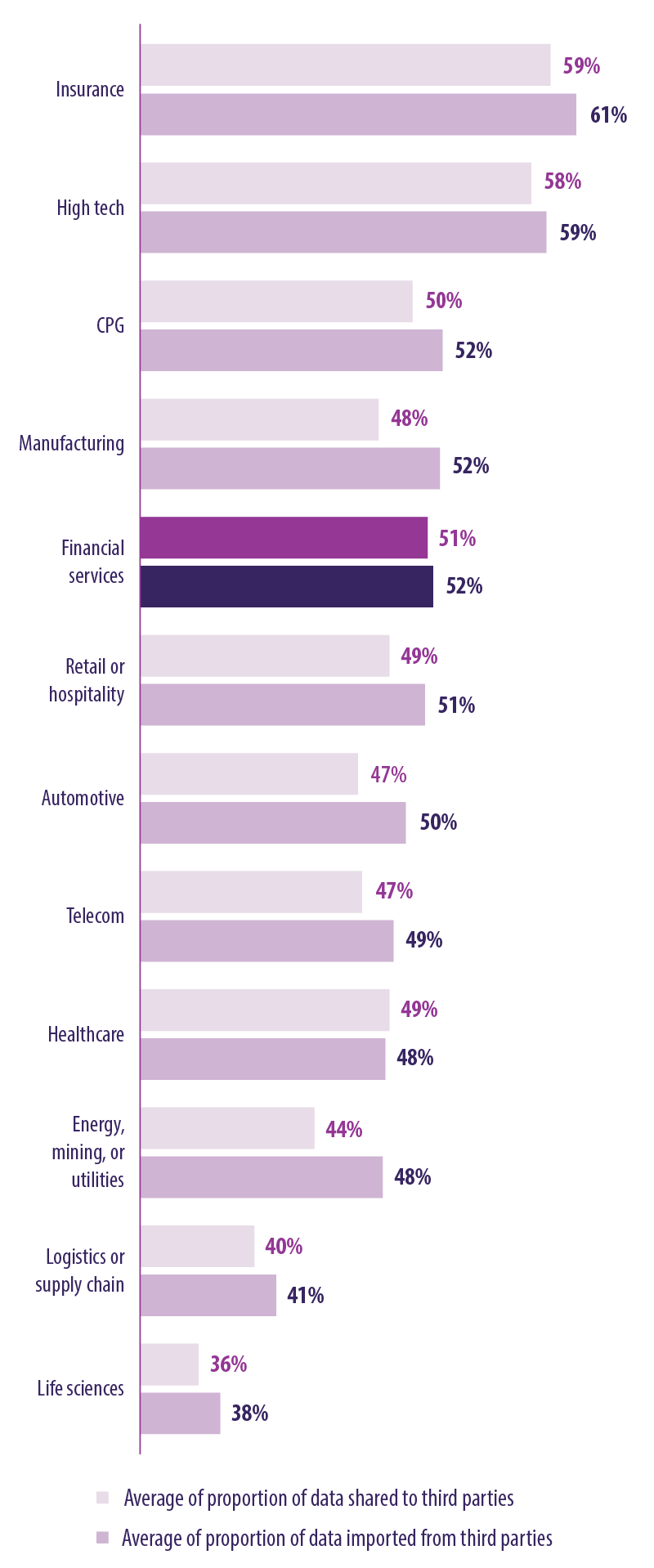
Source: Infosys Knowledge Institute
Business leaders see a full spectrum of AI-informed data uses, Suresh Renganathan, chief technology officer at Teachers Federal Credit Union said. “All leaders would like to see a data-driven business model. Data’s a fuel to propel business growth right now,” he stated. “We want to accomplish personalized experience. We want to enable fast investment decisions. We want to predict and reduce delinquencies, and to track branch performances against objectives. There is a plethora of use cases.”
Data sharing — importing in and sharing out data — helps companies expand their data pool. Advanced AI capabilities and data sharing practices together foster advanced AI and drive deep learning. The Infosys report shows that expanding deep learning and data sharing helps increase corporate profits. More financial services firms (92%) invest in deep learning and share data extensively (Figure 9). It is also a good sign that 69% are doing deep learning in more than 30% of their AI systems (Figure 10).
Figure 9: Deep learning correlates with extensive data sharing
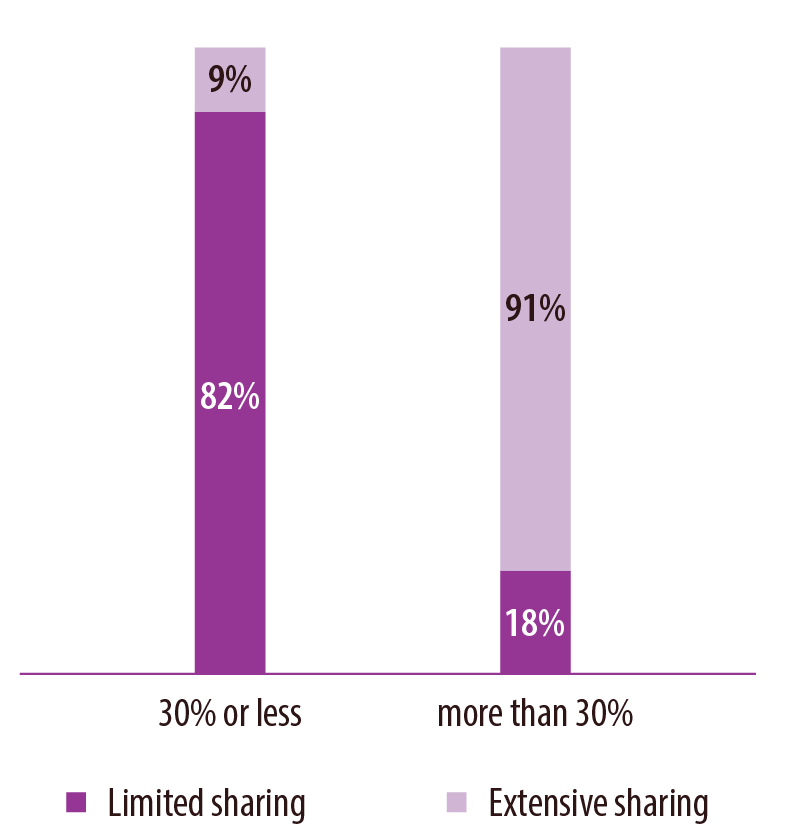
Source: Infosys Knowledge Institute
Figure 10: More financial services firms are doing deep learning
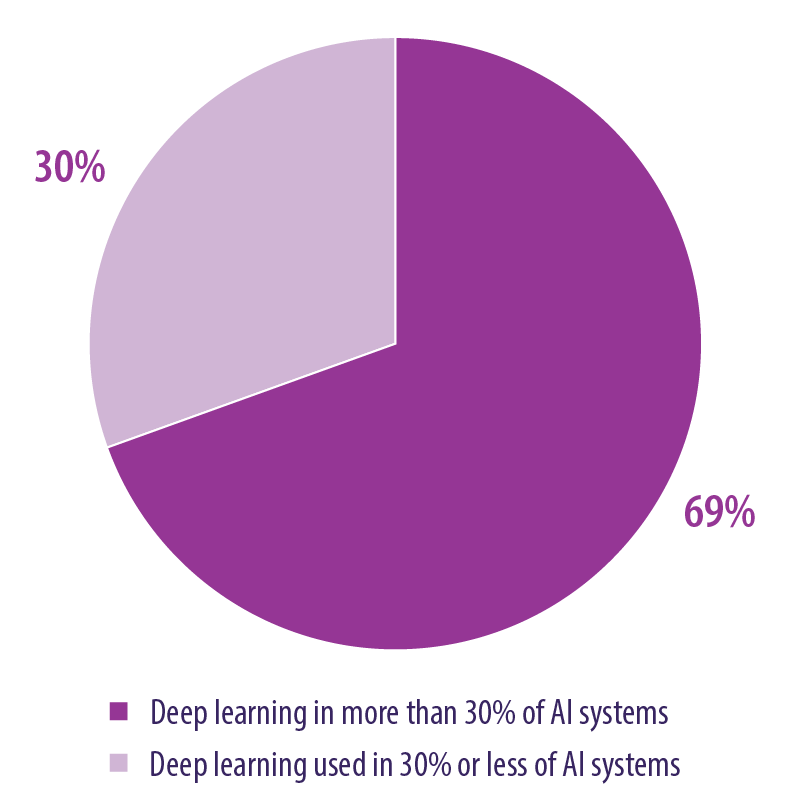
Source: Infosys Knowledge Institute
Financial services firms evidently excel in data verification and deep learning. They have also got it right when it comes to including senior executives and end users in their mix of AI teams, and their data management strategies are evolving. But, to achieve their best, they should consider increasing more business experts in their AI teams and exploring a state between centralization and federation to best suit their circumstances.
5) Strengthen ethics and bias management with responsibility and explainability
AI explainability remains the final frontier. As per experts, employees are more likely to work with AI outputs when they trust that their AI systems are operated responsibly. “Firms must build AI that is explainable and build trust with the humans who interact with it. Only then can businesses realize higher-level benefits of data and AI”, noted Shukla. So, quick and easy understanding of AI is a must for it to work well.
Strong ethics and bias management practices increase trust and satisfaction in data and AI. The report shows that higher the confidence in bias management and ethics, greater the satisfaction with AI (Figure 11). Financial services firms pursuing advanced AI systems must prioritize ethics and bias management to enhance trust in AI. This approach could resolve data sharing challenges and facilitate higher-order capabilities. Governments around the world, on their part, have begun introducing regulations so firms can build ethical, responsible AI. In June 2022, the Canadian government introduced the Artificial Intelligence and Data Act (AIDA) to create a risk-based approach to regulating AI systems. The AIDA ensures its citizens trust the digital technologies they use daily.
Figure 11: Strong ethics and bias management correlate with greater trust in AI
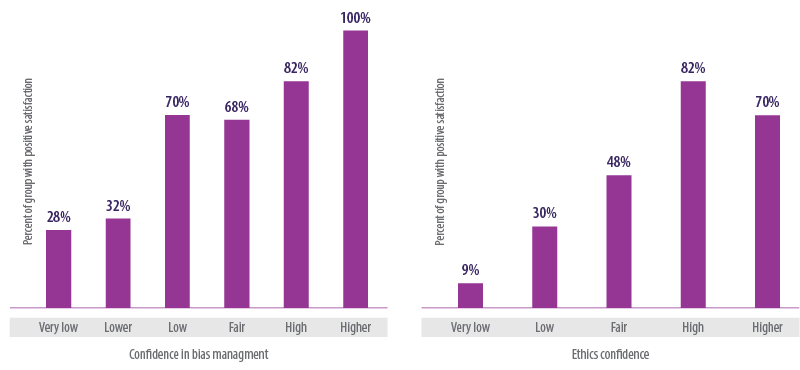
Source: Infosys Knowledge Institute
The Canadian government mandates transparent AI support for administrative decisions, with a focus on deploying automated decision-making systems that minimize risks to clients. It introduced the Algorithmic Impact Assessment (AIA) in April 2020 as a questionnaire tool to determine the impact of automated decision- systems.
6) Building a multidisciplinary AI team
To fully leverage the technology’s effectiveness, companies must adapt their business processes and team structures accordingly. Effective AI also requires an efficient, cross-disciplinary team, comprising data scientists, business problem experts, and senior executives, each contributing specific skills. Data scientists are essential in AI, yet business experts who understand how to address business problems and leaders who ensure alignment with organizational strategies for growth are equally crucial.
While the financial services industry involves senior executives and seeks end user inputs in AI teams, it places higher emphasis on data scientists, 18% vs. 16% for other industries (Figure 12). However, financial services show scope for improvement when it comes to always involving business experts (29% vs. 44% for other industries). Getting the right balance of people in AI teams can effectively address the challenges posed by a lack of experience.
Figure 12: AI teams – financial services vs. other industries
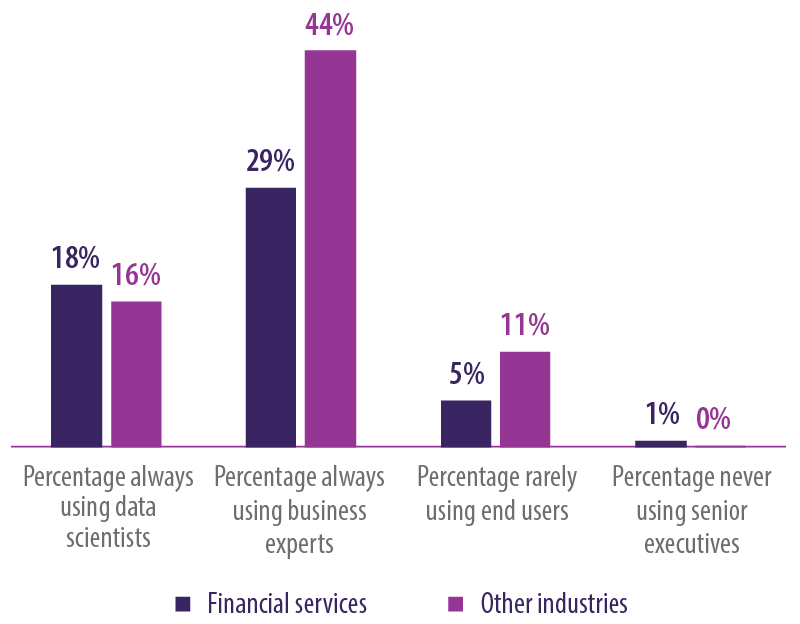
Source: Infosys Knowledge Institute
Again, JPMorgan is an example. The firm has set up a multidisciplinary team, including ethicists, data scientists, engineers, AI researchers, and risk and control professionals, to use AI responsibly and prevent unintended misuse.

